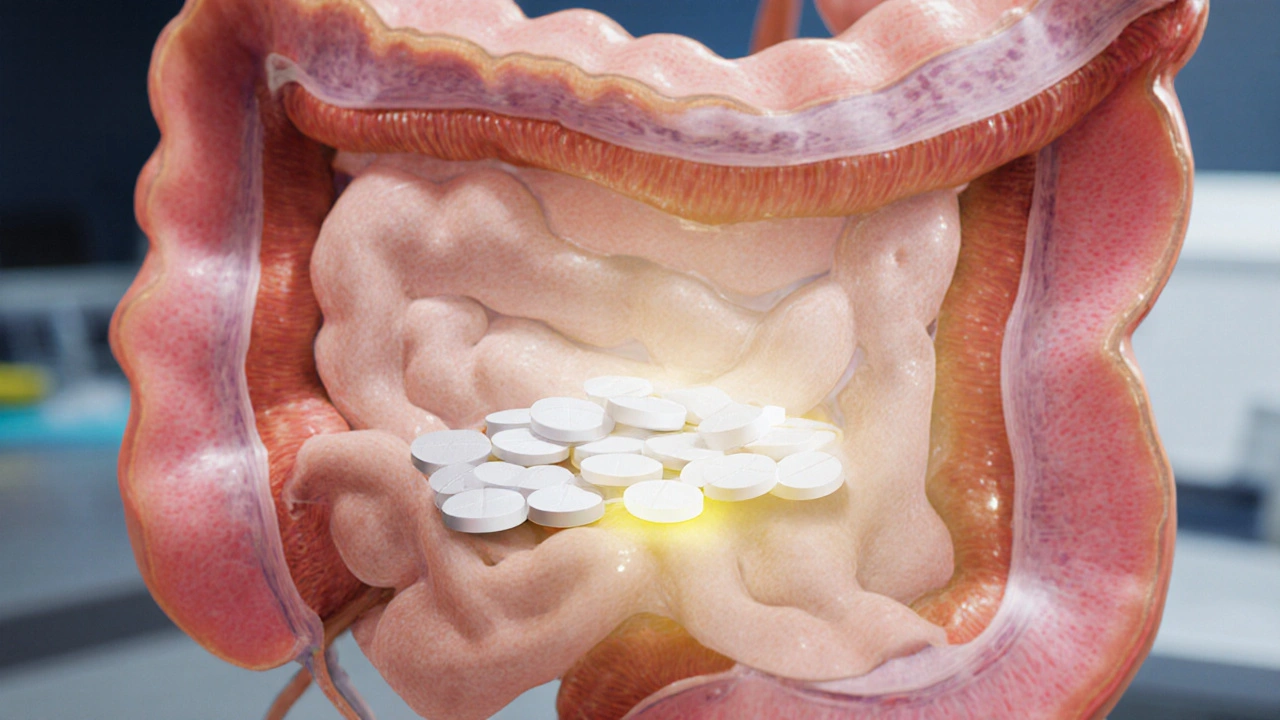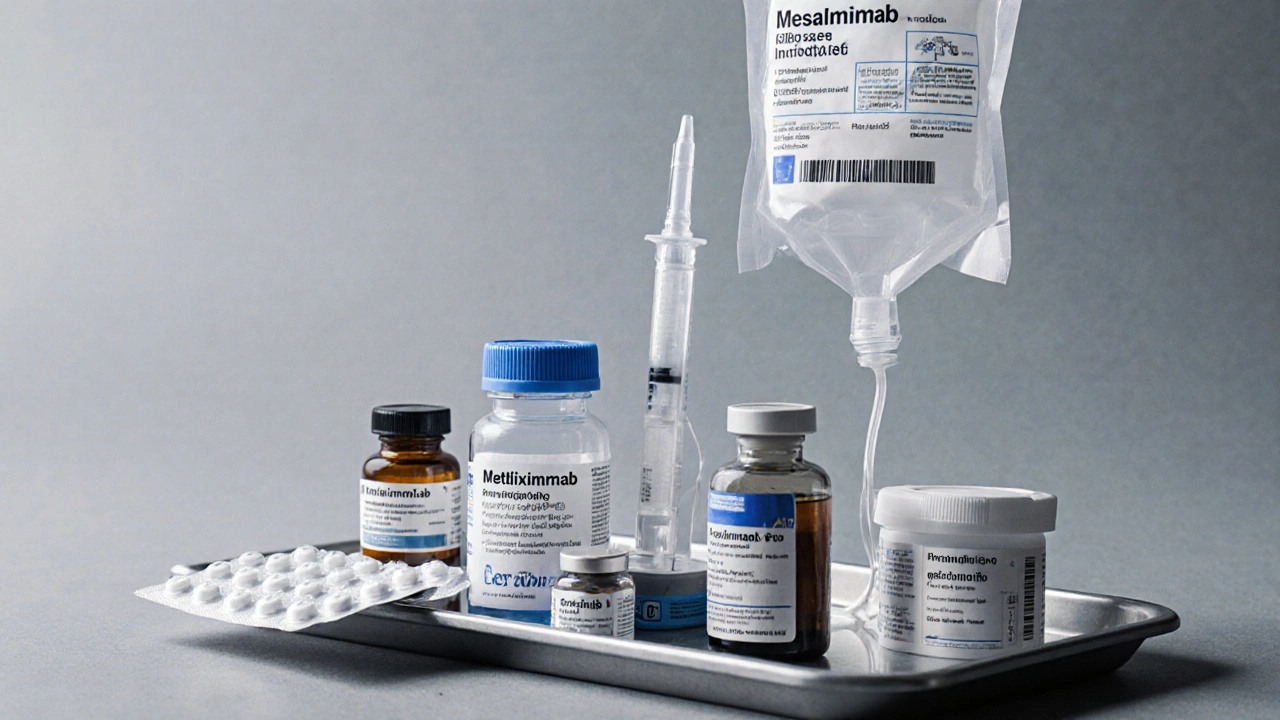Azulfidine (Sulfasalazine) vs Alternatives: Benefits, Side Effects & Cost

IBD Treatment Decision Helper
Recommended Treatment Pathway
Click "Analyze Treatment Options" to get personalized recommendations.
Treatment Comparison
| Drug | Class | Cost (AU$) | Remission Rate | Monitoring Needs |
|---|---|---|---|---|
| Azulfidine (Sulfasalazine) | 5-ASA | 30-40/month | 60% | Quarterly LFTs |
| Mesalamine | 5-ASA | 45-60/month | 65% | Minimal |
| Methotrexate | Immunosuppressant | 25-35/month | 55% | Monthly blood work |
| Infliximab | Anti-TNF biologic | 1,300-1,600/month | 75-80% | Pre-screening + regular checks |
| Adalimumab | Anti-TNF biologic | 1,200-1,500/month | 70-75% | Pre-screening + regular checks |
When it comes to managing inflammatory bowel disease, Azulfidine is a brand name for sulfasalazine, a drug that blends an antibiotic with an anti‑inflammatory compound. Sulfasalazine works by releasing 5‑aminosalicylic acid (5‑ASA) in the colon, where it dampens inflammation, while the sulfapyridine part provides antibacterial activity. It’s been on the market since the 1950s and still shows up in treatment plans for ulcerative colitis (UC) and, to a lesser extent, Crohn’s disease (CD). But with a crowded field of newer options, many patients wonder how it stacks up against the alternatives.
Quick Takeaways
- Azulfidine is effective for mild‑to‑moderate ulcerative colitis but less potent for deep‑seated Crohn’s lesions.
- Common side effects include nausea, headache, and photosensitivity; rare but serious reactions can involve liver toxicity.
- Cost‑wise, sulfasalazine remains one of the cheapest oral options in Australia (≈AU$30‑40 per month for generics).
- Biologic agents (e.g., infliximab, adalimumab) offer higher remission rates but require injections and carry higher out‑of‑pocket costs.
- Choosing the right drug depends on disease severity, location, patient preferences, and insurance coverage.
How Azulfidine Works and Who It Helps
Azulfidine belongs to the 5‑ASA class. After oral intake, colonic bacteria split the molecule, delivering 5‑ASA right where inflammation lives. This local action limits systemic exposure, which is why it’s often a first‑line oral therapy for distal ulcerative colitis. In clinical trials, about 60% of patients achieved clinical remission within 8weeks, especially when the disease is confined to the rectum or left colon.
Because the drug is taken orally, adherence is generally higher than with injectable biologics. However, the sulfapyridine component can provoke hypersensitivity reactions, so a test dose is usually given before full treatment. Monitoring liver enzymes and blood counts every few months is standard practice.
Key Alternatives to Consider
Below are the most common alternatives that physicians weigh against sulfasalazine. Each has its own efficacy profile, route of administration, and side‑effect spectrum.
Mesalamine is a pure 5‑ASA formulation without the sulfapyridine moiety, available as tablets, granules, and rectal suppositories. It’s a go‑to for patients who cannot tolerate sulfasalazine’s side effects.
Methotrexate is an immunosuppressant used off‑label for Crohn’s disease, especially when patients cannot afford biologics. It’s administered weekly by injection or oral tablet.
Infliximab is a chimeric anti‑TNF monoclonal antibody given as an IV infusion every 8weeks after induction. It’s effective for both UC and moderate‑to‑severe CD.
Adalimumab is a fully human anti‑TNF agent administered subcutaneously every 2weeks. It’s approved for moderate‑to‑severe UC and CD.
Prednisone is a systemic corticosteroid used for rapid induction of remission, but long‑term use is discouraged due to bone loss, diabetes risk, and mood changes.
Azathioprine is a purine synthesis inhibitor that works as a steroid‑sparing agent, often combined with 5‑ASA for maintenance therapy.
Tofacitinib is an oral Janus kinase (JAK) inhibitor approved for ulcerative colitis, offering a convenient pill form with rapid onset.

Side‑Effect Snapshot
Every drug carries trade‑offs. Below is a concise look at the most frequent adverse events you might see with each option.
- Azulfidine: Nausea, headache, photosensitivity, mild liver enzyme rise; rare severe rash or blood dyscrasia.
- Mesalamine: Similar GI upset but fewer systemic reactions; rare kidney inflammation.
- Methotrexate: Hepatotoxicity, mouth sores, pulmonary fibrosis (rare), requires folic‑acid supplementation.
- Infliximab/Adalimumab: Infusion or injection site reactions, risk of infections (TB, opportunistic), possible formation of antibodies reducing efficacy.
- Prednisone: Weight gain, hypertension, osteoporosis, mood swings; dose‑dependent.
- Azathioprine: Bone‑marrow suppression, pancreatitis, increased infection risk.
- Tofacitinib: Elevated cholesterol, herpes zoster reactivation, rare thromboembolic events.
Cost Comparison (Australia, 2025)
| Drug | Class | Typical Indication | Remission Rate (≈) | Common Side Effects | Approx. Cost (AU$) |
|---|---|---|---|---|---|
| Azulfidine (Sulfasalazine) | 5‑ASA | UC mild‑moderate | 60% | Nausea, headache | 30‑40 |
| Mesalamine (generic) | 5‑ASA | UC mild‑moderate | 65% | Kidney irritation | 45‑60 |
| Methotrexate | Immunosuppressant | CD moderate‑severe | 55% | Hepatotoxicity | 25‑35 |
| Infliximab (Remicade) | Anti‑TNF biologic | UC & CD moderate‑severe | 75‑80% | Infections, infusion reactions | 1,300‑1,600 |
| Adalimumab (Humira) | Anti‑TNF biologic | UC & CD moderate‑severe | 70‑75% | Injection site pain, infections | 1,200‑1,500 |
| Prednisone | Corticosteroid | Induction for flare | Rapid, >80% (short term) | Weight gain, osteoporosis | 5‑10 |
| Azathioprine | Immunomodulator | Maintenance UC & CD | 60% | Bone‑marrow suppression | 30‑45 |
| Tofacitinib | JAK inhibitor | UC moderate‑severe | 65‑70% | Herpes zoster, cholesterol rise | 850‑950 |
Decision Guide: When to Pick Azulfidine vs Another Option
Think of drug selection as a checklist. Ask yourself these questions and you’ll land on the most sensible choice.
- Disease location: If inflammation is limited to the left colon or rectum, oral 5‑ASA drugs (Azulfidine, Mesalamine) work well. Extensive colonic or ileal disease may need systemic agents.
- Severity: Mild‑to‑moderate disease often responds to Azulfidine. Moderate‑to‑severe cases usually require biologics or JAK inhibitors for faster remission.
- Tolerance: Sulfasalazine can cause photosensitivity and nausea. If patients report these, switch to Mesalamine or another class.
- Pregnancy plans: Azulfidine is category B in Australia and considered relatively safe, while methotrexate is teratogenic and must be stopped pre‑conception.
- Cost & insurance: For patients on the Medicare Safety Net, cheap generics like Azulfidine save thousands annually. Biologics often require private health cover or government assistance programs.
- Monitoring burden: Azulfidine needs quarterly liver tests. Biologics need pre‑screening for TB and periodic infection checks. Choose the regimen that fits the patient’s ability to attend labs.
When the answer points to a cheap, well‑tolerated oral agent, Azulfidine remains a solid first‑line pick. If any of the red flags above appear, move up the ladder to Mesalamine, steroids for induction, or a biologic for long‑term control.

Real‑World Experiences
Jane, a 32‑year‑old teacher from Melbourne, started Azulfidine after a colonoscopy confirmed left‑sided ulcerative colitis. Within six weeks, her stool frequency dropped from seven to two per day, and she reported no drug‑related rash. Her gastroenterologist kept her on a low dose because the cost of a biologic would have strained her private health insurance.
Conversely, Tom, a 45‑year‑old electrician with Crohn’s disease affecting the ileum, tried sulfasalazine twice but never achieved sustained remission. His doctor switched him to infliximab, and after three infusions his abdominal pain and weight loss resolved. Although his out‑of‑pocket cost rose sharply, the improvement in quality of life justified the expense.
Monitoring & Follow‑Up Tips
Regardless of the drug, regular follow‑up is crucial. Here’s a quick schedule you can share with patients:
- Week 0: Baseline labs (CBC, LFTs, renal panel) + pregnancy test if applicable.
- Weeks 4-8: Assess symptom improvement; repeat LFTs for Azulfidine.
- Every 3months: Full blood work for any immunosuppressant or biologic.
- Annually: Colonoscopic surveillance for dysplasia, especially after 8-10years of chronic inflammation.
Early detection of side effects keeps patients on therapy longer and reduces emergency visits.
Frequently Asked Questions
Can I take Azulfidine while pregnant?
Yes, sulfonamides are generally considered safe in pregnancy (category B). However, doctors usually monitor liver function more closely and advise a folic‑acid supplement to offset any mild folate deficiency.
How long does it take for Azulfidine to work?
Most patients notice a reduction in stool frequency and urgency within 4-6weeks, but full mucosal healing may require 8-12weeks of consistent dosing.
Why does sulfasalazine cause photosensitivity?
The sulfapyridine part can act like a light‑sensitive compound, leading to skin reactions after sun exposure. Wearing sunscreen and a hat reduces the risk.
Is there a generic version of Azulfidine in Australia?
Yes, generic sulfasalazine tablets are widely available through PBS and private pharmacies, priced around AU$30‑40 per month.
When should I consider switching from Azulfidine to a biologic?
If after 12weeks there’s no clinical remission, or if disease flares repeatedly despite optimal dosing, escalating to a biologic like infliximab or adalimumab is recommended.
Bottom line: Azulfidine remains a cost‑effective, well‑studied option for people with mild‑to‑moderate ulcerative colitis who can tolerate its side‑effect profile. For more aggressive disease, or when patients hit the ceiling of response, alternatives such as mesalamine, methotrexate, biologics, or JAK inhibitors become the logical next step. Always weigh severity, location, personal preferences, and budget before settling on a regimen.
Donna Oberg
October 6, 2025 AT 15:00Wow! The sheer cost‑effectiveness of Azulfidine is like finding a hidden treasure in a sea of pricey biologics!!! Yet, the photosensitivity side‑effect can turn a sunny day into a nightmare-so don’t forget your sunscreen!!
Garreth Collard
October 17, 2025 AT 20:26In the grand tapestry of IBD therapeutics, sulfasalazine occupies a respectable niche; its historic pedigree is undeniable, yet one must weigh its modest remission rate against the gleaming efficacy of modern biologics.
Daniel LaMontagne
October 29, 2025 AT 01:53Hey folks 😊, if you’re on a tight budget 🤑 and can tolerate the occasional nausea, Azulfidine is a solid starter – just keep an eye on those liver tests! 👍
Gary Levy
November 9, 2025 AT 07:20Considering the disease location is key; for left‑sided colitis, an oral 5‑ASA like sulfasalazine often suffices, while extensive disease may indeed call for something stronger.
sourabh kumar
November 20, 2025 AT 12:46Photosensitivity is a real issue for many patients
Christian Miller
December 1, 2025 AT 18:13It is worth noting that pharmaceutical companies have a vested interest in promoting high‑margin biologics over affordable generics such as sulfasalazine, thereby subtly steering clinical guidelines toward more lucrative therapies.
NORMAND TRUDEL-HACHÉ
December 12, 2025 AT 23:40Azulfidine works but it isn’t the best for severe cases.